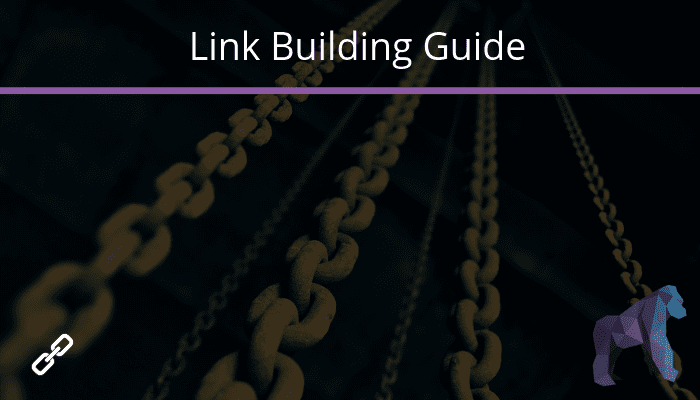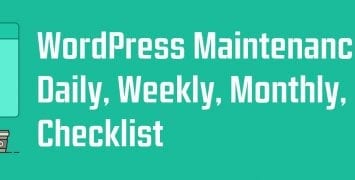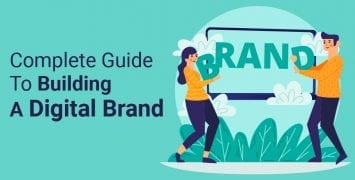Building links is essential for ranking on Google. This has been the case for a while, and it still rings true today. Ranking on the search engines means understanding and building links the right way.
What is the right way?
We’re here to show you the necessary steps to link building and a few tricks along the way in this all-encompassing guide.
There are a ton of great resources out there as well for link building help. We’ll add a list of our favorites to the end of the article.
But for now, let’s lay the foundations for link building success.
Link Building 101
Link building is essentially getting other sites to link back to your own. These inbound links are called backlinks. Rankings in Google can be greatly influenced by the number and quality of backlinks a page has.
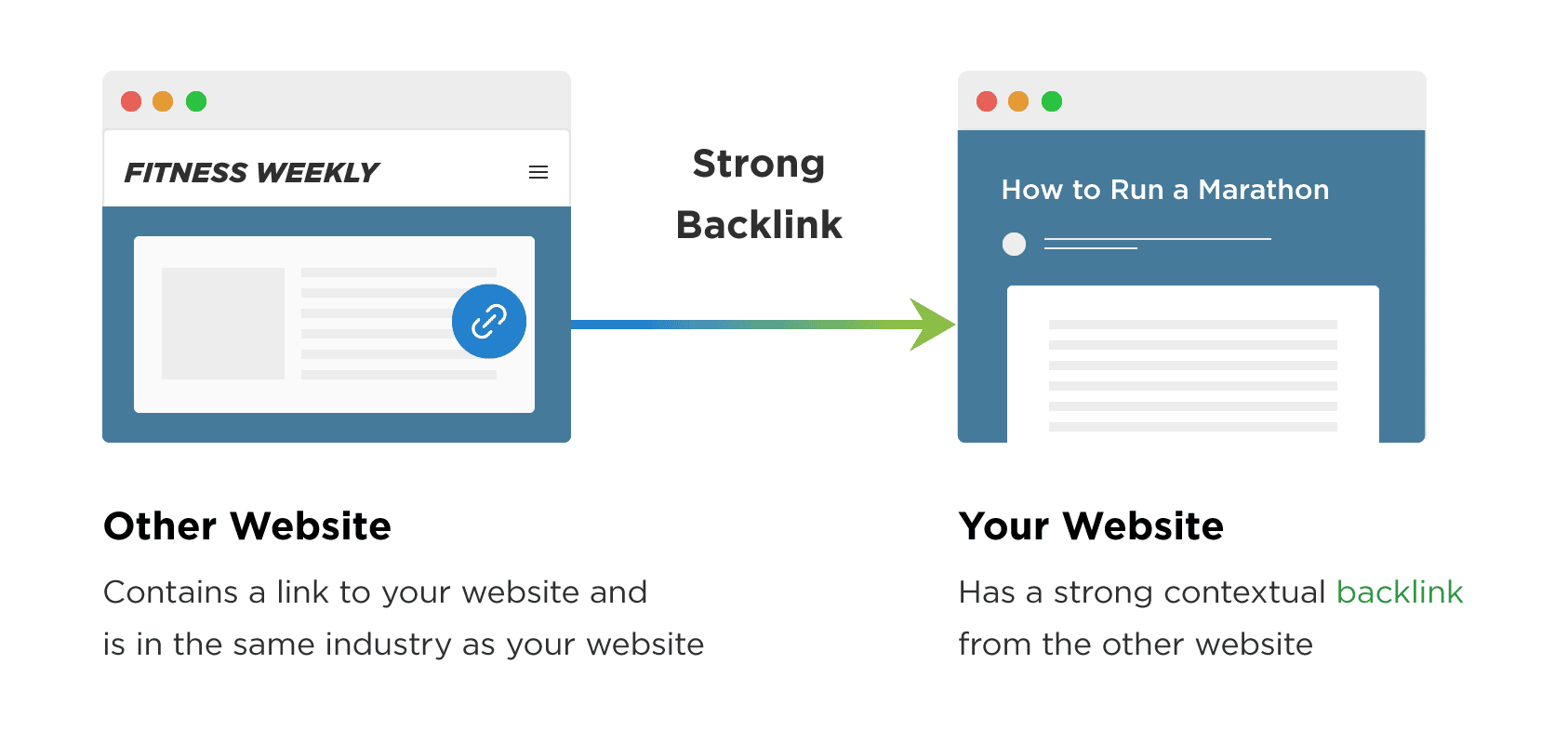
But what kind of links have the most impact?
Well, first we have to understand how these links work. Each link to a page is considered a vote — the more votes a site has, the better it will do in the rankings (in theory).
But the truth is that some sites are worth more in the eyes of Google — those sites can contribute more than others when it comes to link building.
Who’s got the juice
The more links a site builds — the more votes it is able to pass on. This means that high authority sites are able to contribute more when it comes to backlinks than a low authority site that lacks inbound links.
There are a few ways you can gauge if a site is a high or low authority.
- Domain Authority is measured from 0-100. This metric is used to determine how strong an entire site is. The higher the DR (domain rating) the more authority a site has. Hint hint, the more authority-driven links a site has going to it, the higher the DR.
- Page Authority is also measured from 0-100 and is used to determine how strong an individual page is. The higher the rating, the better the links — same as DR.
When looking to get inbound links, you’ll benefit more from those that come from high rated sites and pages. It’s not that you should completely ignore lower authority sites, but those with higher authority will contribute more votes. These sites will also contribute to your legitimacy.
A few side notes
- There has been research conducted regarding anchor text with both exact match, and partial match keywords. While studies do say that it can have a positive correlation with rankings, it’s not necessary and you shouldn’t have to ask for it.
- Unnatural links are a blurry topic. Too many unnatural links can penalize your page. The differences between all of the hats of SEO is worth knowing.
- NoFollow links are different than backlinks. These links don’t play a part in determining a ranking. There is much debate to whether or not this completely true — but mixing in these types of links helps with link diversity. So don’t count out NoFollow links.
Alright, now that we’ve covered the basics…let’s get to the good stuff. The strategies.
The strategies that work
There are so many, almost too many, link building strategies. Sorting through all of the different methods to figure out the best ones is a mess. So we did it for you.
According to Ahrefs, these are the most effective link building strategies from two years ago.
https://ahrefs.com/blog/link-building/ (chart)
In our experience over the years, here are the strategies that still get great results.
Content (Link Bait)
You’ve heard it here, and you’ve heard it everywhere.
“Content is king.”
“Content marketing has taken over.”
“Content, content….more content.”
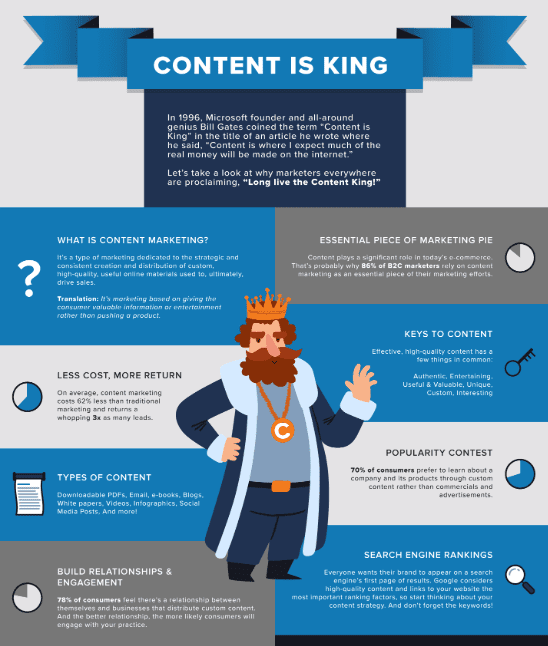
Honestly, the word content has become so obnoxious as a buzzword that many have tried making up their own versions of it. But for the sake of familiarity, we’re sticking with content.
I’m not going to go through the content spiel, you already know it. Create a valuable piece, and it will get shared.
I’m not going to convince you that content works. No.
I’m going to change the way you look at the strategy. You’re using content as a means to lure in links. It’s bait.
Neil Patel is one of the more successful and well known faces around the digital sphere. He’s no stranger to link building either.
Watch how he explains how to take a piece of valuable data and use it as a lure for shares and links.
It’s simple. It takes work. But ultimately, it gets results.
Rebuilding broken links
This strategy takes a bit of recon, and some slight finesse.
There are so many broken links to content out there on the web. It could be for a handful of reasons. The business that created the content no longer exists, or a business created a new webpage. Maybe the link goes back to a dead website that isn’t maintained anymore.
Regardless, the content is a dead end. Maybe you already have the right piece of content on your page, or perhaps during your recon you notice that a lot of these dead links go to a similar piece of content.
Create your own piece of similar or new content that can be used in place of the dead one. Reach out to the site and offer your content as a replacement.
Call us old school, but it works.
Guest Blogging
This one of the more effective ways to get your site in front of a bunch of new audiences. High-quality guest blogging is relatively cheap as well and a popular way to gain new white hat links.
Low risk, high reward. This one is a must.
Infographics (like the one above)
If you didn’t take the time to watch the video earlier in the post with our good friend Neil, you should. He lays out some great link bait tips — but he also talks about the power of infographics.
Infographics work for a few reasons
You can repurpose other content such as videos, blogs or case studies as an infographic
Visual content does better
They help with outreach
The best part is, you don’t have to be a designer. It helps, sure…but there are some great free or cheap tools out there that can help even the layman make an infographic.
Here a few to get you started:
The reason infographics are fantastic for outreach is that they provide value. If you reach out to get some backlinks, it helps to have high quality visual content to offer as free content.
Tools you can use
There are hundreds, if not thousands of tools floating around to help with your link building efforts. Some are great, others are good, most are awful.
We’ll save you the trouble. Here are the tools you can use to get the most out of your link building efforts:
Backlink checkers are tools that allow you to spy a little. Checking in on the competition is a must when it comes to link building. You need to know their strategies and where they are ranking. This will give you some insight into how much work and money you’ll need to put in to rank above them.
We love these guys…we really do. Their backlink resource is second to none. So many tools. Endless reports. Very user friendly resource.
You’ve likely heard of Moz. They have made some waves in the backlink community and continue to invest time and money in growing their index.
Majestic prides itself on having the largest index of backlinks to explore. User-friendly and simple resource.
When it comes to your SEO efforts, we can’t stress enough how important link building is. It’s absolutely essential when it comes to ranking on Google. It also provides a means for outreach and engaging the community at hand.
It takes a certain mindset to be a successful link builder. Honestly, it takes this type of mindset to work well in the marketing world regardless of what you’re doing. But link building is like a science and an art. It takes some left and right brain activity to get the best results.
This doesn’t mean you have to ssingle-handedlybe the one working on both the analytical and creative aspects. But if you don’t possess the ability to do both, have the right people with the right skills in place.
It takes some big picture strategist mindset.
It takes an analytical and research focused mindset.
It takes a creative thought process when it comes to content and new ways to approach link building.
And finally, it takes a networking mindset because outreach is the name of the game when it comes to effective link building.
Maybe you’re an extremely talented individual that possesses all of the endearing quality of a proficient marketer. But most likely, you’re going to need some help. ( some sort of CTA? )
In part 2 of our not-so-little link building guide, we’re going to delve a little deeper into a few of the necessary things you’ll need to master the art of link building. We’re going to go over a few skills, strategies and tools that can get you started today with your link building efforts.
Link Outreach
We’ve been mentioning outreach a lot, but what does this really mean?
Outreach is probably the most difficult skill to get right — but it’s also crucial. You can sit around all day and pray to the digital gods that your content goes viral. If that’s your plan…good luck.
If that’s not your plan, you’re in the right place and state of mind. To get your content out there, seen and shared — you’re going to need it in the right people’s hands.
And yes…this means email.
Reaching out and providing your content as “free” collateral for link building will do a few things for you.
It will get you backlinks and boost your rankings for whichever keywords your targeting.
Help you build your network and become a trusted and valuable source for content.
Refine your outreach and email skills. Email is a skill that always needs sharpening.
A word to the wise — do your outreach at the right time.
We mentioned Ahrefs in Part 1 of this series, and we’re going to mention them a few more times because their tools are diverse…and they work. They have a great service called Ahrefs Alerts that will notify you when someone mentions the keyword you are aiming for.
This your time to shine. Reach out when you see that they mentioned the keyword your tracking and provide your resource. Boom, backlink.
Back to the strategy board
Let’s get to the good stuff, the juicy center, the strategies.
In Part 1 we discussed a few things, here’s a refresher index.
- Content/Link Bait
- Rebuilding broken links
- Guest Blogging
- Infographics
If you want the details, go check it out and come back. This info will be waiting.
Influencers
There’s a reason why we prefaced this article with a section on outreach, because you’re going to need it to tackle this strategy.
We’re not sure why, but most people dismiss influencers as an option because it seems “impossible” to get their attention. It seems “unattainable” to get a response. It seems “unrealistic” to expect one of them to share your content.
This mindset is dumb. Sorry, we’re not sorry.
Reaching out to influencers provides virtually no risk and all reward. Here’s a little tip:
People are egotistical creatures by habit. Influencers are egotistical creatures as a job.
We don’t mean that in a bad way by any means. Influencers simply understand their value and maintain their career by getting others to be guided by their lifestyle and choices.
But this means you can play to their ego. Here’s how:
Mention them in a piece about experts, a top 5 list or “best in the field of” article
Read their socials, find a saying or piece of advice — and quote it with a link to their site
Reach out for an interview, play them up in the email
These are just a few ways, but there a tons more. You never know what influencer may bite and create an avenue for link building.
Interviews
Speaking of interviews, these don’t just have to be influencers. Thought leaders, experts and professionals are all resources you can use to build credibility while naturally building links.
Interviews come in many forms, and as times change they are becoming more and more visual and auditory. Contrary to the style used in this article, people would rather watch or listen to a piece of content. But this especially true for interviews.
- Podcast
- Video interviews
- Expert roundups
- Blog interview
It’s an excellent way to have an expert take in a niche that people with pick up and link to. This a traffic building powerhouse that is often underused.
Newsjacking
This an effective way to get extremely high quality links back to your site.
The catch…it’s not easy.
Newsjacking is essentially putting your own brand into a story of trending news.
But you have to be quick about it. Trending news is fleeting and happens almost instantaneously. It’s about creating content with a unique twist on the story. Producing something from an angle that is different from the rest will help you slip past the competition.
Repurposing your content
While we mentioned this before with infographics, this tactic can be used in many ways. It’ll save you time and money too, so there’s that.
Not everything can be said in a blog post. Not many people want to read 1500 words. Thisn’t necessarily a bad thing. It just means that you now have many ways you can dress a message or a piece of value.
Take a blog post and reshape it.
Make it a video
Make it a podcast
Make it an infographic.
Make it an eBook.
Make it whatever you want.

All of these different avenues provide a different way to get backlinks. You’re also diversifying your content to appease different audiences. Don’t silo your audiences into different content spheres.
Local Citations
This a method that has held true for a while. It’s almost always the first thing we ask when speaking with a client about their SEO efforts. But for some reason, we see it is often missed.
Citations on business directories provides an initial interaction with your business and shouldn’t be taken lightly. These directories also only accept legitimate businesses. Therefore Google places a little more trust in them.
Paid links
Buying links continues to be one of the most popular and utilized avenues for link building. Sites such as Forbes, Entrepreneur and Huffington Post all have placements for paid link services.
It’s a touchy subject though, as Google does state they can penalize you for abusing this tactic. But as of now, it remains one of the most used ways for link building.
Tools you can use
Ah, behold the many tools and tricks for researching and getting the most out of your targeted keywords.
We’re back to save you the trouble of trying to find the most effective ones. In Part 1 we discussed the best backlink checkers for checking in on the competition.
Now we’ll discuss the best:
- Outreach tools
- Web monitoring tools
- Freelance tools
Outreach tools are usually just email. But there are some great services that can help you build up your contact database and help with tracking. Here are two of our favorites.
Buzzstream is a fantastic tool with robust capabilities. This service can build a list of prospects and create a campaign. It also has templates available and great tracking abilities top it off.
We love chrome extensions so it’s no surprise that one of them made the list. Track open rates and link clicks while being able to split test. Oh and of course, templates.
Web monitoring tools are necessary for effectively building on your outreach. Monitoring the web for any new mentions of your target keyword is a must.
Clever name eh? Monitor any time your keyword is mentioned on the web or even social media. It’s simple, it’s sleek and it works.
Ahrefs tool is pretty diverse. It allows you to set up email alerts for any new mentions of your keyword or brand. It also alerts to any new backlinks to your competition.
This one is free but has more limited capabilities. You’ll only get an alert when they index new content, so it won’t be as timely.
Freelance tools are where you’ll outsource the things you can’t do, don’t want to do or don’t possess the right mindset to do.
As we mentioned in the beginning of this post, link building takes diverse skills and it’s OK if you don’t have them all. That’s why we’re providing some great resources to find freelancers that are proficient in their niche.
Another clever name. Freelancer has a diverse workforce for different link building tasks. Check them out to learn more.
Design Pickle has you covered for all of your graphic design needs. We actually first heard of these guys through their viral marketing campaign, but they do incredible work.
Why Links from Small Sites Should Be Your Bread and Butter
When it comes to link building, clients often have in their mind the idea of getting links from the biggest players in their industry and often from some of the most authoritative news websites. While these links can be obtained, they usually require large amounts of effort, they are costly, and they may have less impact than you imagine.
For this reason, links from smaller sites should be your bread and butter. They will make up the bulk of your link profile, and there may be no large sites linking to you at all. Despite what you might think, this perfectly normal, and many sites rank incredibly well without links from more significant sites.
Quantity is Important
The number of links that you get pointing to your site and inner pages is important. It’s not the only factor, but the quantity of referring domains is the metric most closely correlated to ranking high. For this reason, you want to try and get as many links as possible, presuming they are good quality and relevant.
In reality, there are only a small amount of large sites in any niche, and even when you expand that scope to consider large news publications and generalist sites, the number is still tiny. Most of the web consists or niche websites which focus on a particular industry and they are often run by a single person or a small business.
If you want to get more than a handful of links you will need to expand your scope to include these smaller sites, many of which are incredibly relevant to your business and would be quality backlinks. By working with a variety of smaller sites rather than focusing your efforts on getting links from one more significant site you can increase the number of links pointing to your pages.
Smaller Sites are Often More Relevant
After the Google Penguin update relevancy has become more important, particularly regarding the content on the page containing the link, and the content on the receiving page. Most of the large sites on the web are generalist sites which is why they can become so large.
While links from them can be beneficial, it’s unlikely that they are going to be as directly related to your business as a far smaller niche website could be. In fact, if you are running a car dealership, a link from a repair company could be far more powerful than a link from Business Insider or another general site like Forbes.
Many experts believe that Google now uses a modification factor to increase or decrease the ‘strength’ of a link depending on its relevance to the domain that it’s pointed at. If that’s true, which would make sense, then your link profile should be as relevant to your industry as it can be.
It’s Natural
If you look at the link profile of any serious website that hasn’t tried to manipulate their rankings via black hat tactics, you’ll find that the majority of their links are from pages that you’ve never heard of. Having most of your links coming from large publications isn’t realistic, and it’s not natural.
Google analyzes millions of lines of data each day to determine what they think is a natural link profile. Using Penguin and possibly other filters, they are penalizing sites which they believe have unnatural link profiles which could be evidence of attempted rank manipulation.
To avoid these penalties, and to get the most significant benefit from your links, the bulk of your link profile should consist of smaller sites as any natural link graph would be.
Big Sites Often Have Poor Interlinking
Perhaps the greatest reason to shift your focus from large brands to smaller niche pages is that the impact of a link from a big magazine or publication is often tiny. They interlink sparingly, with minimal strategy, mainly if they are covering news.
This lack of interlinking means that an individual page can often become orphaned, meaning that it’s not linked to from any other page on the domain. If this the case, the page linking to you will have very little Page Rank and is, therefore, unable to pass much ‘link juice’ on to your page.
Smaller sites, on the other hand, have fewer pages and are often categorized well with massive interlinking which means that a page on a more modest site may be stronger than one on a larger site.
That’s All Folks!
Well, there you have it…everything you need to get started with link building. What are you waiting for? Get out there and start building!
If you think you’re going to need a hand, don’t worry you’re not alone. We’ve helped countless clients build links and rank on Google. It may seem like a lot of work from this guide, but it’s the work we love to do! Check us out and contact us to learn more about our link building services!

